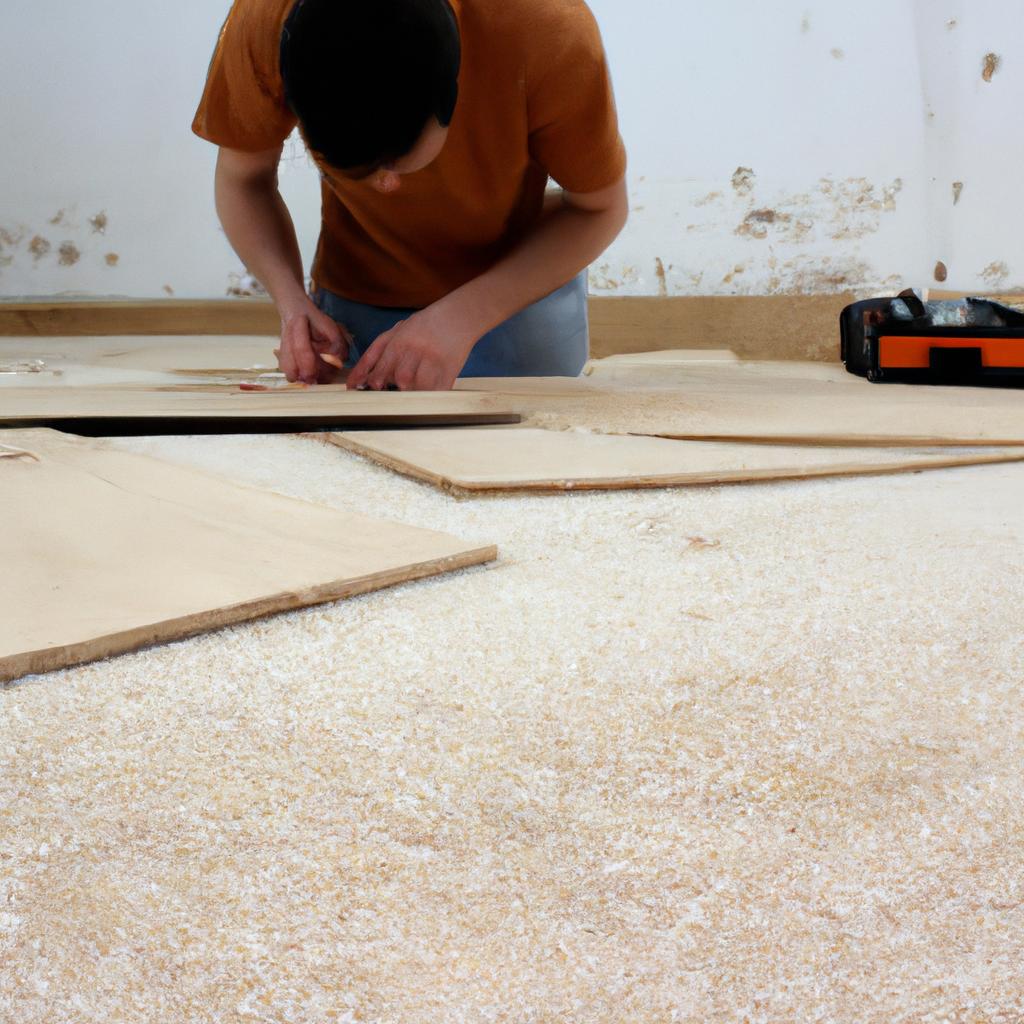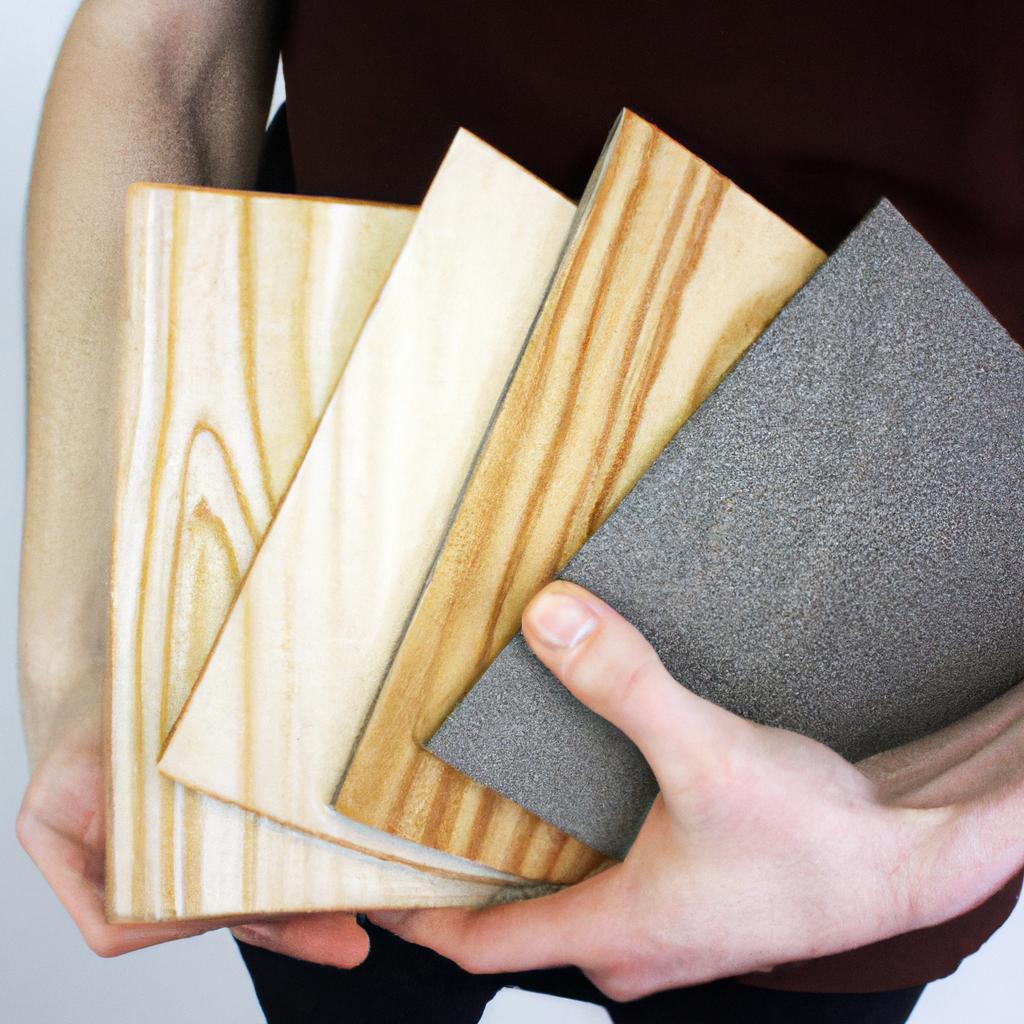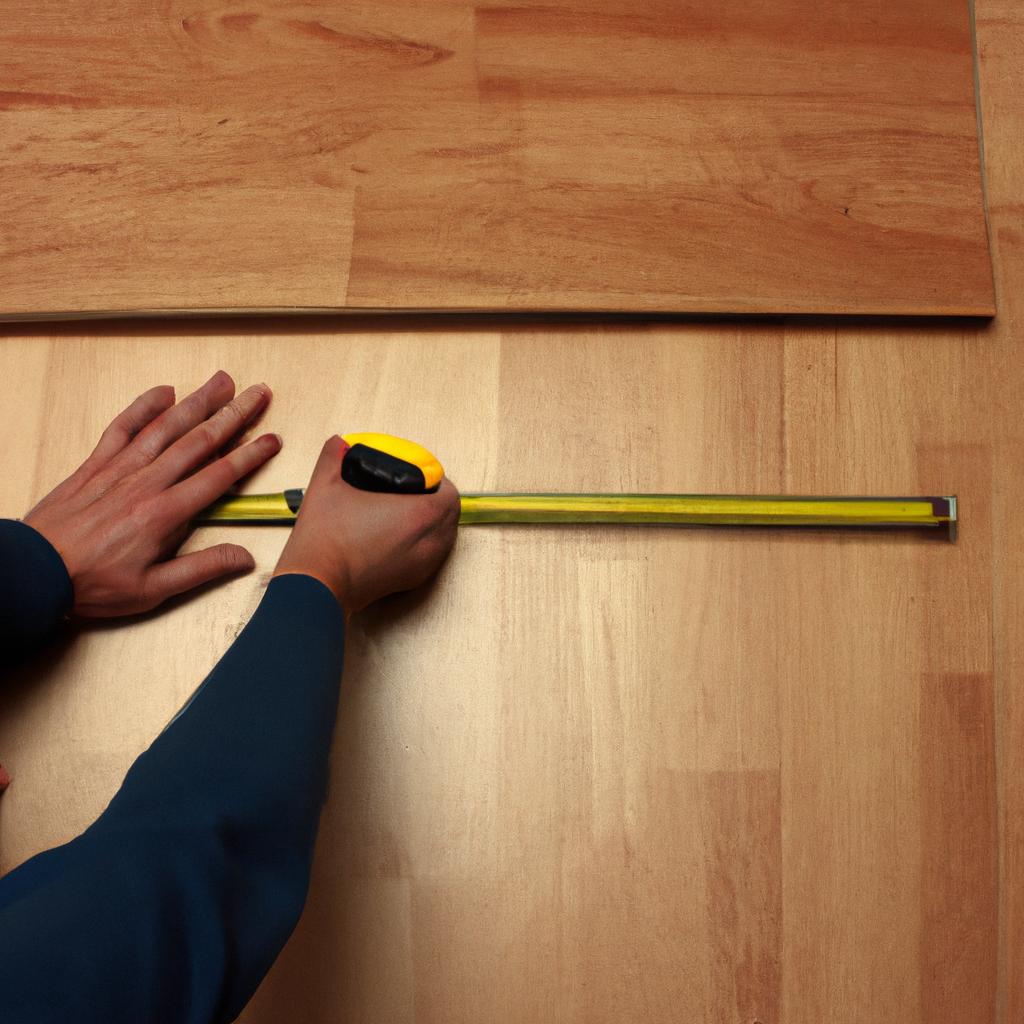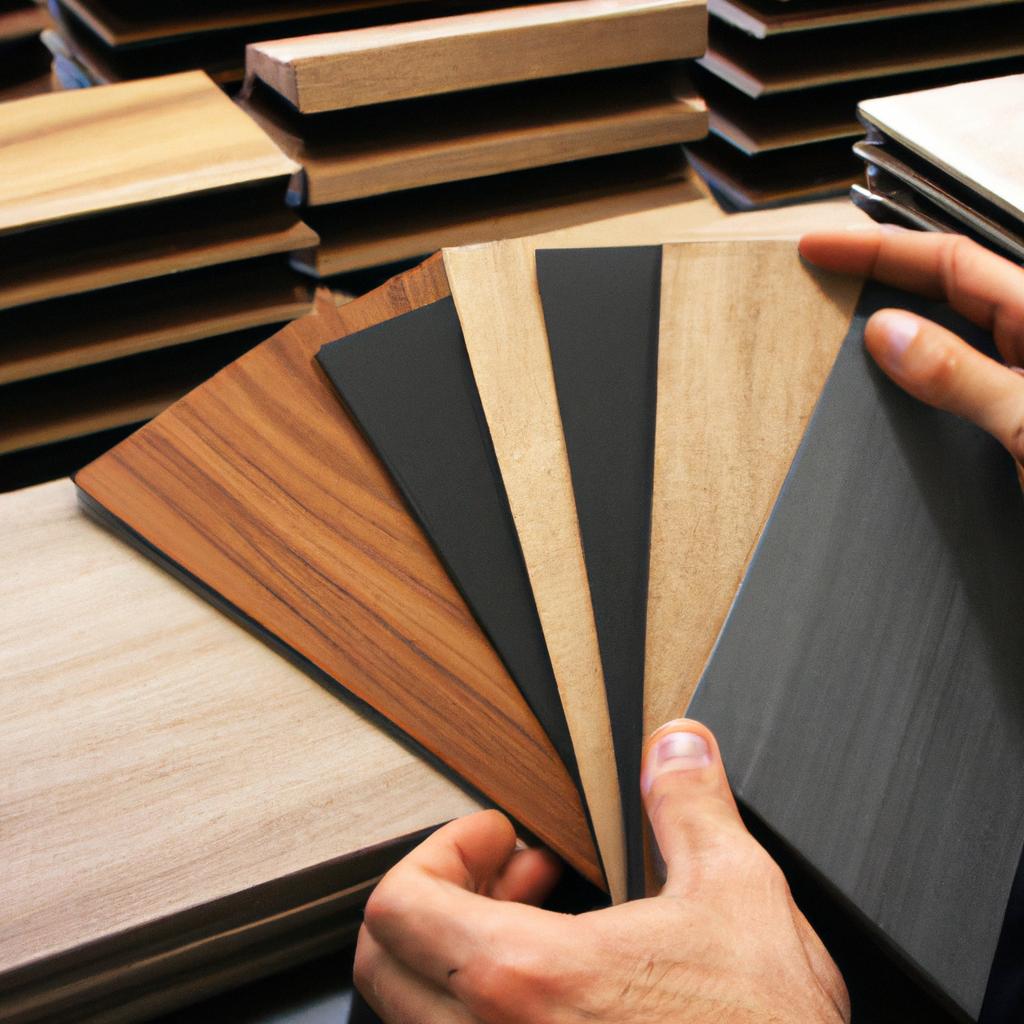Plywood is a versatile and widely used building material that offers strength, durability, and aesthetic appeal. In the context of lumber and building materials, understanding the different types of plywood is essential for professionals in the construction industry. For instance, consider a scenario where an architect needs to select suitable plywood for constructing a durable roof structure. Without knowledge about the various types available and their specific characteristics, they may end up with an inadequate choice that compromises the integrity of the entire project.
This comprehensive guide aims to provide a detailed overview of the different types of plywood commonly found in lumberyards today. By exploring their composition, properties, and applications, readers will gain valuable insights into selecting appropriate plywood for their specific projects. Additionally, this article delves into important factors to consider when choosing plywood, such as grade classifications, veneer quality, thicknesses available, and environmental considerations. Whether you are a professional contractor or someone interested in DIY home improvement projects, this guide will equip you with the knowledge necessary to make informed decisions regarding plywood selection in any construction endeavor.
Marine Plywood: A durable and water-resistant option for applications in wet environments.
When it comes to choosing the right plywood for specific projects, one notable option is marine plywood. As its name suggests, marine plywood is primarily designed for use in wet environments such as boats and docks. Its unique composition makes it highly resistant to water damage, making it a popular choice among builders and contractors alike.
To illustrate the practicality of marine plywood, consider the case study of constructing a wooden deck near a swimming pool. In this scenario, traditional plywood would be susceptible to moisture absorption, leading to warping and deterioration over time. However, by opting for marine plywood, which has been specially treated with waterproof glue and overlaid with phenolic film or resin-impregnated fiber overlays on both sides, you can ensure that the deck remains structurally sound even when exposed to constant splashes of water.
One key advantage of marine plywood lies in its durability. This type of plywood typically consists of multiple layers or plies that are bonded together using high-quality adhesive materials. These layers provide increased strength and stability compared to regular plywood sheets. Moreover, the presence of an overlay coating enhances resistance against abrasions and chemicals commonly found in damp environments.
In addition to its exceptional performance under wet conditions, marine plywood offers other valuable features:
- High impact resistance
- Excellent dimensional stability
- Superior screw-holding capacity
- Longevity
The table below summarizes some key properties of marine plywood compared to standard-grade exterior plywood:
| Property | Marine Plywood | Standard Exterior Plywood |
|---|---|---|
| Water Resistance | Very High | Moderate |
| Strength | High | Average |
| Durability | Exceptional | Good |
| Price | Higher cost | Lower cost |
As demonstrated by these characteristics, marine plywood stands out as a reliable material for projects that require durability and water resistance. In the subsequent section, we will explore another type of plywood known for its strength and versatility: hardwood plywood.
Hardwood Plywood: Known for its strength and versatility, ideal for furniture and cabinetry.
Marine Plywood, known for its durability and water resistance in wet environments, presents an excellent option for various applications. However, when it comes to furniture and cabinetry projects, Hardwood Plywood emerges as a strong contender due to its strength and versatility. Let’s explore the characteristics of Hardwood Plywood further.
Imagine you are designing a custom kitchen cabinet set that requires both durability and aesthetic appeal. With Hardwood Plywood, you can achieve this balance effortlessly. For instance, consider a hypothetical case study where a homeowner desires sturdy cabinets with a beautiful finish. By using Hardwood Plywood panels for the cabinet boxes and doors, they can benefit from the following features:
- Exceptional Strength: The solid hardwood veneer layers provide superior strength compared to other types of plywood. This makes it ideal for heavy-duty applications like cabinetry.
- Beautiful Aesthetics: The natural grain patterns visible on the surface lend an elegant touch to any project. Whether stained or painted, the inherent beauty of hardwood shines through.
- Versatility in Design: Hardwood Plywood is available in various species such as oak, maple, cherry, or birch—each offering distinct colors and textures. This diversity allows designers to create unique pieces tailored to their customers’ preferences.
- Enhanced Durability: In addition to being resistant to warping or shrinking under environmental changes, Hardwood Plywood also withstands wear and tear over time exceptionally well.
To visualize these advantages more effectively, let’s take a look at the table below comparing some key attributes of different plywood options:
| Attribute | Marine Plywood | Hardwood Plywood |
|---|---|---|
| Water Resistance | High | Moderate |
| Strength | Moderate | High |
| Appearance | Neutral | Natural Grain |
| Cost-effectiveness | Moderate | Higher |
As shown above, while Marine Plywood excels in water resistance, Hardwood Plywood surpasses it with higher strength and a more visually appealing finish. These attributes make it an excellent choice for furniture and cabinetry projects.
Transitioning to the next section about Softwood Plywood, we explore another popular option commonly used in construction projects. With its lightweight nature and cost-effectiveness, Softwood Plywood offers practicality without compromising on quality or performance. So let’s delve into the characteristics of this plywood variety as we continue our exploration of lumber and building materials.
Softwood Plywood: Lightweight and cost-effective, commonly used for construction projects.
Section Title: Softwood Plywood: An Economical Solution for Construction Projects
Imagine you are a homeowner planning to build an outdoor shed in your backyard. You want a durable yet affordable material that can withstand the elements while staying within budget. This is where softwood plywood comes into play. In this section, we will explore the features and benefits of softwood plywood and its relevance in construction projects.
Features and Benefits:
Softwood plywood offers several advantages that make it an ideal choice for construction projects:
-
Cost-effective: One of the primary reasons builders opt for softwood plywood is its affordability compared to other types of wood panels or alternatives like solid hardwood. It allows individuals on tight budgets to still achieve their desired project goals without compromising quality.
-
Lightweight yet sturdy: Despite being lightweight, softwood plywood maintains structural integrity and strength. Its inherent stability enables easy handling during installation, making it popular among DIY enthusiasts as well.
-
Versatile applications: Softwood plywood finds extensive use in various construction projects such as roofing, flooring, wall sheathing, and subfloors due to its durability and dimensional stability.
-
Availability: Softwoods like pine, fir, spruce, and cedar are commonly used to manufacture softwood plywood. These woods are readily available in most regions, ensuring accessibility for builders across different locations.
Emotional Bullet Point List (Markdown format):
- Cost savings: By choosing softwood plywood over more expensive materials, you can allocate your resources towards other aspects of your project.
- Efficiency: The lightweight nature of softwood plywood simplifies transportation and installation processes.
- Durability: Softwood plywood’s structural stability ensures long-lasting performance even under demanding conditions.
- Versatility: From framing structures to finishing touches, softwood plywood adapts seamlessly to a wide range of applications.
Table Example (Markdown format):
| Application | Advantages | Disadvantages |
|---|---|---|
| Roofing | Lightweight and easy to install | Requires regular maintenance |
| Flooring | Durable and provides good insulation | Prone to scratches and dents |
| Wall Sheathing | Enhances structural strength, improves energy efficiency | Limited aesthetic appeal |
| Subfloors | Provides a smooth surface for flooring installation | Vulnerable to moisture damage |
With its economical nature and versatility in construction projects, softwood plywood offers an attractive option. However, if you are considering materials suitable for exterior applications such as siding or roofing, the next section will explore the features of exterior plywood designed explicitly for outdoor conditions.
Next Section: Exterior Plywood: Designed to withstand outdoor conditions, suitable for siding and roofing.
Exterior Plywood: Designed to withstand outdoor conditions, suitable for siding and roofing.
Softwood plywood is a popular choice for construction projects due to its lightweight nature and cost-effectiveness. However, when it comes to exterior applications where weather resistance is crucial, exterior plywood takes the lead. Designed specifically to withstand outdoor conditions, it offers enhanced durability and longevity compared to other types of plywood.
To illustrate the importance of using exterior plywood in outdoor settings, let’s consider a hypothetical scenario. Imagine a homeowner who decides to build a backyard shed for storage purposes. For this project, they opt for softwood plywood due to its affordability. After completing the shed, they notice that within just a few months, the plywood starts warping and deteriorating under exposure to rain and sunlight. This unfortunate outcome could have been avoided by choosing exterior plywood instead.
When selecting materials for exterior use, there are several key factors to consider:
- Weather Resistance: Exterior plywood is designed with glue formulations that provide superior moisture resistance. It can withstand varying weather conditions without significant damage.
- Durability: The layers of veneer in exterior plywood are bonded together using water-resistant adhesives such as phenol formaldehyde or melamine urea formaldehyde. These adhesives enhance the strength and durability of the material.
- Core Construction: Exterior plywood typically has multiple layers (plies) with an odd number of plies for added stability. The core construction ensures that the panels remain flat and resist warping even when exposed to moisture.
- Surface Finish: With an emphasis on performance rather than aesthetics, exterior plywood often features rough surfaces suitable for further treatment or cladding application.
Table: Benefits of Exterior Plywood
| Benefit | Description |
|---|---|
| Enhanced Durability | Resistant to rotting, warping, and delamination |
| Weatherproof | Withstands exposure to rain, snow, UV rays |
| Versatility | Suitable for various outdoor applications such as siding, roofing, and outdoor furniture |
| Longevity | Offers a prolonged lifespan compared to softwood or other types of plywood |
In summary, when it comes to exterior applications that demand resilience against the elements, opting for exterior plywood is essential. Its superior weather resistance, durability, core construction, and suitability for rough finishes make it the ideal choice for siding, roofing, and other outdoor projects. Next in our comprehensive guide is an exploration of decorative plywood, which offers a wide range of visually appealing finishes for interior design purposes.
Decorative Plywood: Offers a wide range of visually appealing finishes for interior design.
Now, let’s explore Decorative Plywood, which offers a wide range of visually appealing finishes for interior design. To better understand its significance and potential uses, consider the following example:.
Imagine you’re designing a luxurious hotel lobby that requires sophisticated aesthetics. In this case, Decorative Plywood can be utilized to create stunning wall panels with intricate patterns and textures. By incorporating decorative plywood into your design scheme, you can enhance the visual appeal of the space while maintaining durability.
When it comes to Decorative Plywood, there are several key aspects worth considering:
-
Versatile Design Options:
- Unique veneer patterns: From traditional wood grains to modern abstract designs.
- Textures: Smooth or embossed surfaces add depth and dimension.
- Finishes: Choose from glossy, matte, or satin coatings based on desired aesthetic results.
-
High-Quality Materials:
- Premium hardwood veneers ensure superior visual appeal.
- Durable core materials provide structural stability for long-lasting performance.
- Bonding agents used during production maintain the integrity of the panel.
-
Suitable Applications:
- Interior walls and ceilings in residential spaces such as living rooms or bedrooms.
- Hospitality settings like hotels, restaurants, or bars where elegance is paramount.
- Commercial offices aiming to create a professional yet inviting atmosphere.
Consider the table below showcasing some popular types of decorative plywood along with their unique characteristics:
| Type | Features | Suitable For |
|---|---|---|
| Walnut Veneer | Rich dark brown color; prominent grain pattern | Upscale residential projects |
| Ash Veneer | Light-colored wood with subtle grain | Modern office interiors |
| Oak Veneer | Classic appearance; visible knots | Traditional home decor |
| Maple Veneer | Smooth, light grain; excellent for staining or painting | Contemporary designs |
Incorporating Decorative Plywood into your interior design projects can bring a touch of elegance and sophistication. By selecting the appropriate veneers, textures, and finishes, you have the flexibility to create truly unique spaces that leave a lasting impression.
As we move forward in our exploration of plywood types, let’s now delve into Structural Plywood: Engineered for load-bearing purposes commonly used in construction.
Structural Plywood: Engineered for load-bearing purposes, commonly used in construction.
Having explored the world of decorative plywood, we now turn our attention to structural plywood. This type of plywood is specifically engineered to meet load-bearing requirements and is widely utilized in various construction projects. To illustrate its practical applications, let us consider a hypothetical scenario where an architect incorporates structural plywood into the design of a residential building.
Section:
Example Scenario:
Imagine an architect named Sarah who specializes in designing sustainable homes. She recently undertook a project to construct an eco-friendly residence that maximizes energy efficiency while providing adequate strength and durability. In her quest for suitable materials, she opted to incorporate structural plywood as part of the building’s framework due to its renowned strength-to-weight ratio and versatility.
Structural Plywood Features:
Structural plywood possesses several key features that make it well-suited for load-bearing purposes. Here are some notable characteristics:
- Strength and Durability: Structural plywood exhibits exceptional strength capabilities, enabling it to withstand heavy loads without compromising its integrity over time.
- Stability: Due to its cross-laminated composition, this type of plywood offers enhanced dimensional stability compared to solid wood, minimizing warping or twisting issues commonly associated with natural timber.
- Moisture Resistance: Properly treated structural plywood can resist moisture-related problems such as swelling or rotting, making it ideal for exterior applications exposed to varying weather conditions.
- Fire Resistance: Certain varieties of structural plywood have inherent fire-resistant properties, ensuring improved safety measures within buildings during potential fire incidents.
Table showcasing Comparative Properties:
| Property | Solid Wood | Structural Plywood |
|---|---|---|
| Strength | Varies | High |
| Dimensional | Moderate | Excellent |
| Stability | ||
| Moisture | Low | High |
| Resistance | ||
| Fire Resistance | Varies | Yes |
These characteristics, combined with its cost-effectiveness and ease of installation, have contributed to the popularity of structural plywood in construction projects worldwide. Architects, contractors, and builders rely on this versatile material for various applications such as roof sheathing, flooring systems, walls, and even concrete formwork.
Incorporating structural plywood into her eco-friendly residential project allowed Sarah to achieve both sustainability goals and optimal functionality. By utilizing this reliable building material, she not only ensured the strength and stability of the structure but also contributed to reduced environmental impact through efficient resource utilization.
Thus, understanding the unique attributes and advantages of structural plywood empowers professionals within the construction industry to make informed decisions when selecting appropriate materials for their projects without compromising quality or safety standards.
 Bergmann Lumber
Bergmann Lumber



